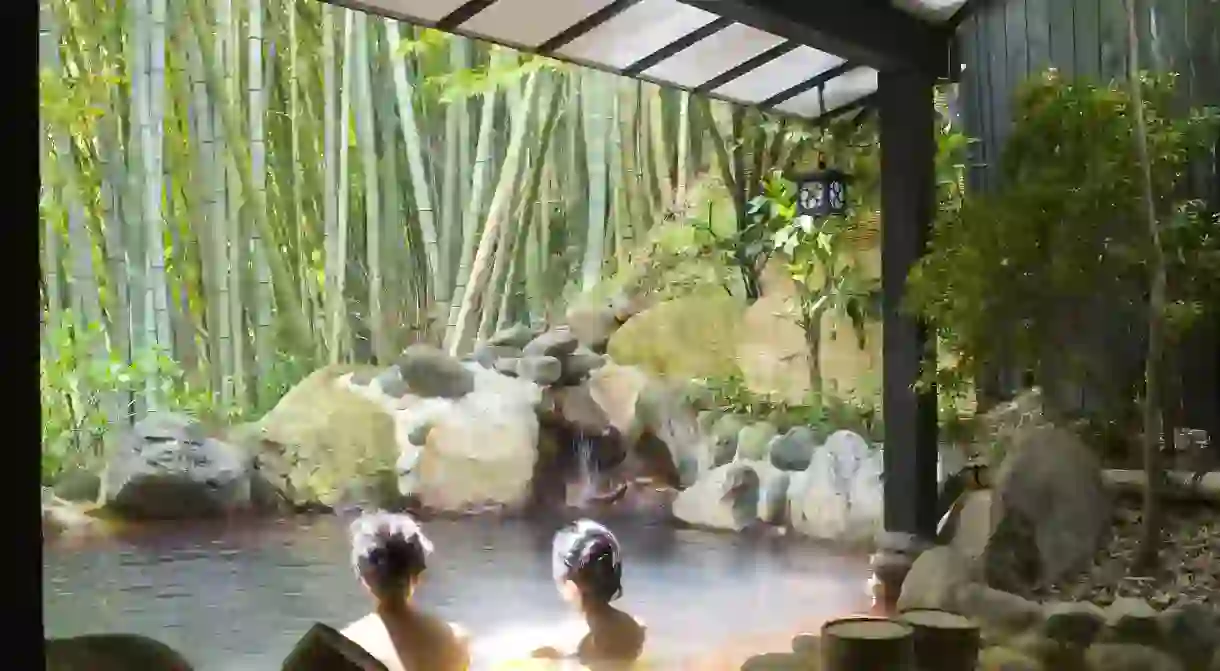The Best Public Onsen in Hakone, Japan

Hakone is one of Japan’s most famous and popular hot-spring towns. Here, discover the history of hot springs in Hakone, and find out where to go for a good soak.
Hakone is a mountainous, volcanic region an hour outside of Tokyo, and has been one of Japan’s most famous onsen towns for centuries.
Hakone’s onsen have a long history of providing respite for travellers as far back as the Edo period, when seven spring-water sources were discovered in the region in the 17th century. The tranquil spas were popularised after being depicted in numerous well-known 19th-century ukiyo-e prints, which prompted people to visit Hakone for short-term stays and daytime soaks. It was around this time that bathing in an onsen evolved from a long-term therapeutic practice to a must-do tourist activity in Japan.

The establishment of an electric railway between Tokyo and Hakone saw the region’s popularity soar. Ryokan and inns proliferated in the area, each offering private hot-spring facilities to guests. Today, hundreds of hot springs in bathhouses and ryokan are powered by 17 spring-water sources, each with their own qualities and benefits.
If you’re not staying overnight in Hakone, here’s where to find the best public hot springs open to day trippers in Hakone.

Tenzan Onsen
Spa
Yumoto, regarded as the gateway to the wider Hakone region, is the oldest known hot spring in the area. Baths and inns here offer gentle, pure water that’s said to relieve aching joints and muscles. One of the best public bathhouses for an authentic hot-spring experience is Yumoto’s Tenzan Onsen, a long-standing bathhouse in a traditional Japanese building with a maze of outdoor and indoor pools. Open-air baths are surrounded by lush woodland, while inside, guests can enjoy a sauna, get a massage and slurp up soba noodles.
Hakone Kowakien Yunessun
Spa
A complex of hot spring baths, pools, water slides, saunas and more, Yunessun spa is a novel take on the traditional onsen. Guests can choose to soak in energizing coffee baths, rejuvenating wine baths and even Japanese sake baths, while families with kids are invited to enjoy a variety of pools and mountain water slides. Unlike more traditional bathhouses in Hakone, swimsuits are permitted, and some areas of the resort allow covered tattoos.
Hotel Green Plaza Hakone
Eco Hotel
This three-star hotel in the scenic hills of Sengokuhara houses one of the only outdoor baths in Hakone boasting views of Mount Fuji, and as the hotel opens the onsen for day use, you needn’t be a guest to experience it. Hot springs here are powered by skin-smoothing sodium bicarbonate water distinct to the Sengokuhara region. Please note that tattoos are strictly not allowed, unless they’re small enough to be covered with a Band-Aid.
Hakone Yuryo
Spa
This mountainside day spa, accessible via a free shuttle bus from Hakone-Yumoto train station, offers several types of baths, including indoor and outdoor baths, pottery baths and more. Visitors can enjoy a sauna, massages and other spa treatments here, but there’s nothing quite like simply soaking in the steaming open-air onsen while taking in views of the surrounding forestland and the sound of the nearby Haya River. Private baths are also available to book up to a month in advance.
Hakone Kamon
Spa
Offering a selection of indoor baths and rotemburo (outdoor onsen), Hakone Kamon is a traditional ryokan with hot-spring facilities open to day trippers. Baths here are on the more intimate side, with open-air pools hugged by trees and decorated with stone. A sauna, outdoor foot bath and a bento box lunch can be enjoyed alongside the onsen, and a cup of tea is served to guests at the end of their visit.













